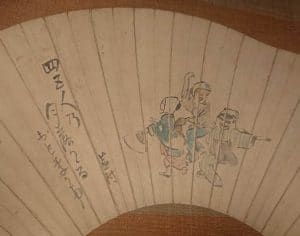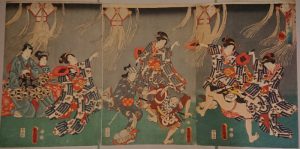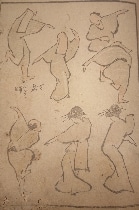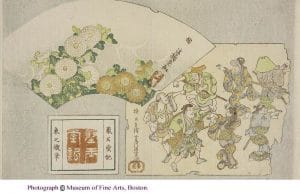Overview
Culture develops as the economy grows and the society becomes stable. Under a certain degree of control, Bon Dancing becomes matured. Early written records of the Bon Dances danced today appears, and the direct relationship with the Bon dances of today became clear, establishing the basis for the traditional Bon dances that continue to be danced today. On the other hand, Bon dances in the three major cities of Edo, Kyoto, and Osaka were suppressed and the dance became events of local villages.
This period
The Edo period was a period of stability. Policies changed from time to time as the government prioritized austerity and economy. The culture of the Bunka-Bunsei period is centered in Edo, in contrast to the Genroku culture of the previous period. While the isolation of the country continued, the unique Edo culture was established and a stable system was established in the provinces. Toward the end of the Edo period, after the arrival of Perry, public opinion was divided mainly on relations with foreign countries, and thereby the national system was shaken.
.
Circa 1700-1866
1711-16: Reign of Shoutoku
1716-45 Kyoho Reforms
1751-86 Tanuma period
1782-88 The Great Famine of Tenmei
1787-93 Kansei Reforms
1804-34 Bunka-Bunsei (Grand Imperial Court) period
1841-43 Tempo Reforms
1853: Perry’s arrival to Japan
1858 U.S.-Japan Treaty of Amity and Commerce
1858-65: Revere the Emperor and Expel the Barbarians Movement
1866: Satcho alliance
1867: The Great Restoration of Japan
Basic Information
Population: Around 30 million, growing rapidly over 100 years
Attribute types: Nobles, monks, samurai, farmers, craftsmen, merchants. More than 80% are peasants. Towns and villages developed with merchants and industrialists. (Castle towns, lodging towns, etc.)
Longevity: 40 years old
Famine and disaster conditions: A bad harvest every few years, a major famine once every 50 years
Media of transmission: Expansion of education, such as temple schools, spreading the number of people who could handle written media to rural areas.
Entity system: Ownership by feudal lords and administration by local magistrates
Common people’s clothing: The spread of kosode and yukata, which were similar to modern kimonos
Common people’s food: Minor cereal rice containing Japanese millet, foxtail millet, and wheat, with side dishes consisting mainly of vegetables
Dwelling of the common people: Hottate-style dwellings with thatched roofs, row houses (one-story apartment buildings) for the townspeople
Entertainment opportunities for the common people: Bon dances were banned in large cities, and developed as a place for men and women to meet and enjoy the season in rural areas and regional cities.
Religion and belief
Terauke system: Establishment of Danka (a supporter of a Buddhist temple)
Reorganization of religious sects under the “honmatsu system
Mixture of Shinto and Buddhist customs: Folk customs and Buddhism also mixed.
→Obon is a mixture of Buddhist events (temple’s bon) and folk customs (village’s bon)
Bon Odori: Events of the time
Trend of local dances and songs, and their mutual adoption
The content of Bon Dancing became more mature.
Appearance of “Kouta” and “Kudoki”
Appearance of “Shamisen
With the appearance of musical accompaniment, Bon Dancing became more colorful and entertainment-oriented.
Names of Bon Dancing
Kouta, Kudoki.
“Koiuta (love songs)” increased, and Kudoki in the form of stories also appeared. Kudoki was greatly influenced by the “narrative culture.
In this way, the content became more entertaining and lost the original meaning of requiem.
Bon Odori Culture
Establishment of Obon
Obon became firmly established as a means of sending off and welcoming the spirits of the dead and ancestors, and Bon Dancing also became an important event as a “memorial dance.
Bearers
.
From urban places like Kyoto and the townspeople to (village) communities. Bon Odori became de-elite and truly an art form for the common people. It is thought to have strengthened the aspect of ancestor worship.
At the same time, however, it also became the object of communal constraints, as participation was strictly enforced.
A Place for Men and Women to Meet
On summer nights, Bon Odori became a place for men and women to meet and have sexual relations.
It had both, selection of marriage partners aspect and uninhibited night crawling side,
These customs are believed to have existed as far back as the Heian period (794-1192), and are thought to have merged together with the establishment of Bon Odori. It is also thought that marriage and sexual intercourse in rural areas were more liberal than in urban areas.
This tendency for Bon Odori to be a meeting place continued until the early Showa period in some areas. (In the regional description of dances west of Tottori Prefecture, the last example of a Bon Odori marriage is described by the actual name of the person who performed the Bon Odori dance.)
The theory is that the meeting place shifted from going to the mountains in March, to the rice planting festival season, to the Bon Odori period, to the autumn festival (Kunio Yanagida, Yamauta no koto, etc.)
Fighting
.
Ondotori compete with each other by singing, exchanging snide remarks, and appealing to each other with their dances and costumes. Serious fistfights are also held. It is also a place for young people to vent their energy.
Transmitter
.
Thorough suppression of the sacred. The “Shimbochi” and “Gan-nin-bouzu” that appear in Bon Odori and folk performing arts today are traces of the former Sage, who was suppressed and lost.
The route of transmission also changed.
Dress
.
Yukata became the norm for everyday wear. The basic form of the current Bon Odori attire was established.
Geta, kosode, furisode
Bon dance sung in haiku and songs
| Literary name | author | era name | AD | Content |
|---|---|---|---|---|
| Sanka chochuka | unidentified | Meiwa9 | 1772 | A collection of Bon Odori and other folk songs from various countries. |
| Shokoku bonodori | Ryutei tanehiko | Same content as "Sankachochuka", re-selected by Ryutei Tanehiko. | ||
| Buson kushu | Yosa Buson | 1700s | The moon is falling on 45 people (Odori-no-Odori) (Odori = Bon Odori, a seasonal word in Autumn) | |
| Kansee Kucho | Kobayashi Issa | Kansei | 1700s | That's the spirit of the Bon Festival dance |
| Bunka Kucho | Kobayashi Issa | Bunka | 1800s | Even a house in the shadow of a mountain is a place to dance |
| Hinano hitofushi | Sugae Masumi | Tenmei3 | 1783 | Description of Bon Dance Song |
| Ryokanzenji kiwa 32 | Kera eiju | 1800s | Around the middle of the first month of the lunar calendar, when the local people were enjoying the evening, the Kyoshi was fond of this and would pick at his head with his handkerchief, and would look at his wife's face, and when he learned that she was a teacher, he stood beside her and said, "I am her daughter, and she is a woman," and the others were proud to hear this and said, "I am her daughter. | |
| Hachisu no Tsuyu | Ryokan | The wind is pure, the moon is whispering, and now let us dance together to the last vestiges of old age. | ||
| unknown | Ryokan | I will stand and dance, and the moon will shine on me this night. | ||
| Letter addressed to "Yamada Toko | Ryokan | The night of the autumn, when all have not yet danced together, without knowing the presence of the deer in the forest. | ||
| Kiryomanroku | Kyokutei Bakin | Kyuowa2 | 1802 | However, there are many people who participate in the Rokuzai Nembutsu. The six-day Buddhist memorial service is performed by peasants from outside of Kyoto, who play drums and sing funny songs while adults and small children beat the drum and walk around the city, some of them wearing shabby sugekasa (bamboo hats). This year, due to the flooding in the neighboring countries, there was no news of it. The women of the streets, from fifty-six to eleven to twelve years of age, were all helping each other out. They sing long songs from the Genji catalog. It is just like the Bon Festival songs of Edo. This is the Komachi Dance. |
| Kiyu shoran | Kitamura Nobuyo | Tenpo1 | 1830 | There is a description about Bon Odori. |
| Kawai Tsugunosuke Den | around1845 | He loved to sing folk songs, especially the Nagaoka Bon Dance. At that time, Nagaoka's Bon Festival dances were not so popular, and there was a lot of noise in the form of Niwa-uta poetry and dancing at night. The dances were held at night, and I heard that the dance around the corner of Komuraya was a big deal. My mistresses were not allowed out of the house even a step at night, so I do not know the details, but I do know that the dance could not be held unless everyone in the house led the music, and they would talk loudly about "Omi Genji" and other stories, and the English clothing stores would put together monuments made of white and blue crepe. My brother loved this Bon Festival dance, but because samurai were forbidden to join in, he could not go out in public, so he would go out only when he was 178 years old. When my brother was 17 or 18 years old, he once put on his mistress's Mooka yukata, hid his face with a hand towel, and told his mother, "Don't tell your mother. |
Buson haiku collection
Yosa Buson 1700s
“The moon is falling on 4 to 5 people dancing.

Fan with Buson’s poem (a collection of Shonan Bon Dance Study Group)
Kansei Kucho
Kobayashi Issa, Late Kansei Period>
That’s why we forget our duties, Bon Odori
Ryokan monk
The wind is clear, the moon is whispering, let us dance together to the last vestiges of old age.
Bon dance depicted
Bon dances are depicted in ukiyoe and other works. The famous Katsushika Hokusai also painted several of them. We can see how it is connected to the Bon Odori of today.
Katsushika Hokusai: 1760-1849

Katsushika Hokusai Bon Odori, Collection of the Art Institute of Chicago, public domain verified
High-quality image of a single brushstroke score.
Umegawa Tohkyo: Ansei~Bunkyu (19th Century)
Bon Odori paintings with materials of the past topic: Hishikawa Moronobu states that it has been created with reference to “Bon Odori”. Work by Umekawa Tohkyo.
Utagawa Kunisada (Utagawa Toyokuni III): 1786-1865
Tanehiko Ryutei’s illustrations for his book “Nise murasaki inaka genji “gained a reputation as “Genji-e” (Genji pictures). The Twelve Months of Genji is based on this work. The Bon Odori (Bon dance) is depicted in the autumn of the year from the Twelve Months of Genji.

Uju from the Twelve Months of Genji (Collection of the Shonan Bon Dance Study Group) )
High quality image of Ushu from the Twelve Months of Genji
The direct roots of Bon Odori that remain in the present day and the mid-to-late Edo period
, for which there is a solid record in literature.
Many literary materials and traditions can be verified to exist, and it is easy to confirm what can be called the direct lineage of Bon Dancing in the present day.
Streams of influence
Haiya folk songs
Ushibuka Haiya → spread throughout the country via sea routes
Examples: Awa Odori dance, Sado Okesa dance
Ise (Kawasaki) Ondo
Originating in Ise, it spread throughout the country through travelers visiting Ise.
Gujo Odori (Kawasaki)
Utazaimon, Deloren Saimon
Saimon (ritual text)
Performing arts of storytelling and singing originally based on prayers to the gods and Buddha.
Brief History of Ritual Texts
Wishes addressed to the gods and Buddha, read by Onmyoji and others (ancient times) → Shinto-Buddhist syncretization by mountain priests, use of conch shells (medieval times) → Addition of shamisen to bring it closer to the common people (early modern times) → Appearance of a variety of performing rites (mid- to late-Edo period)
Utazaimon and Deloren Zaimon are folk songs in which stories and current events are narrated and sung, and developed in the latter half of the Edo period.
These songs became the direct source of the later Koshu Ondo and Kawachi Ondo.
Early written records of Bon dances in various regions
Gunjo Odori (dance)
Tomeki (notes) (Kyoho 8 (1723), Kyomombo document)
Dancing at the shrine during the Bon Festival
Kansei era (1789-1800) Manzu-cho (Awaihara document)
“Every year on the seventh day of the August, we dance at our shrine…”
Kemanai Bon Dance
Fourth year of Bunka era (1807)
Masumi Sugae, “Hina no Hitofushi
Bon Odori Bon Odori O-no-Saka Fushi, Nishiki-no-Tsui no Hen Bon Odori, Kefu no Miyako (now called Kazuno), Onashikuni-furi Muffu no Sato (now called Kazuno).
This is a big slope with seven bends.
At the middle of the hill, there is a bend in the road, and the sun is shining.
* Column “Muneharu Tokugawa’s Bon Dancing”
Muneharu Tokugawa, lord of the Owari domain, adopted an open-door policy in response to the austerity measures of Yoshimune Tokugawa during the Kyoho period.
His tenure was short, from 1730 to 1739, and he was placed under house arrest due to his profligate policies.
Soon after Muneharu became lord of the Owari domain, he held a large-scale Bon dance during the Bon Festival. The scene is described in “Yume no Ato (After the Dream).
It seems to remind of the joyful sight of the common people who, until the previous generation, spent the austere Bon season in a state of austerity.
Although Muneharu’s reputation is divided, he is still often spoken of as a fascinating figure due to this drastic policy.
The dance was a rare and lively affair in July, with costumes of all kinds being splendid, but on the fifteenth day a messenger arrived to inform us that one of the children, Princess Hakko, had passed away on the twelfth, and that we should keep quiet until the seventeenth… The following is another request: on the 24th of the same month, the first day of August, on both days and nights, the streets of the Bon Festival will be crowded with people, and on both days, the streets of the Bon Festival will be filled with people dancing and the streets will be filled with lanterns. In the middle of 6-chome, there is a signboard with the names of the actors written on it, and in the middle of 6-chome, there are lanterns of all ages at Yotsutsuji in Hirokoji, which attract crowds of spectators.
History of Bon Dance
- 0-1 The History of Uraabon
- 0-2 Ancient Japanese customs of the common people (not documented)
- 0-3 Late Heian Period, just before the birth of Bon Dancing
- 1.Kamakura Period Birth of Dancing Nembutsu
- 10.Heisei Reiwa: From Stagnation to the Birth of a New Axis
- 2.Birth of Bon no Furyu Odori (Bon Dance) in the mid-Muromachi Period
- 3.Late Muromachi – Sengoku – Azuchi-Momoyama Rise of Fuuryu Odori and Regional Expansion
- 4.Early Edo Period Establishment of Bon Dancing
- 5.Mid to Late Edo Period Bon Dancing takes root and matures
- 6.Meiji: A Turning Point for Bon Dancing
- 7.Taisho Era – Early Showa Era Revival of Bon Dancing
- 8.Before and After the War Wartime Response, Suspension and Resumption
- 9.Late mid-Showa period Nationwide expansion of Ondo and Minyo (folk songs)


